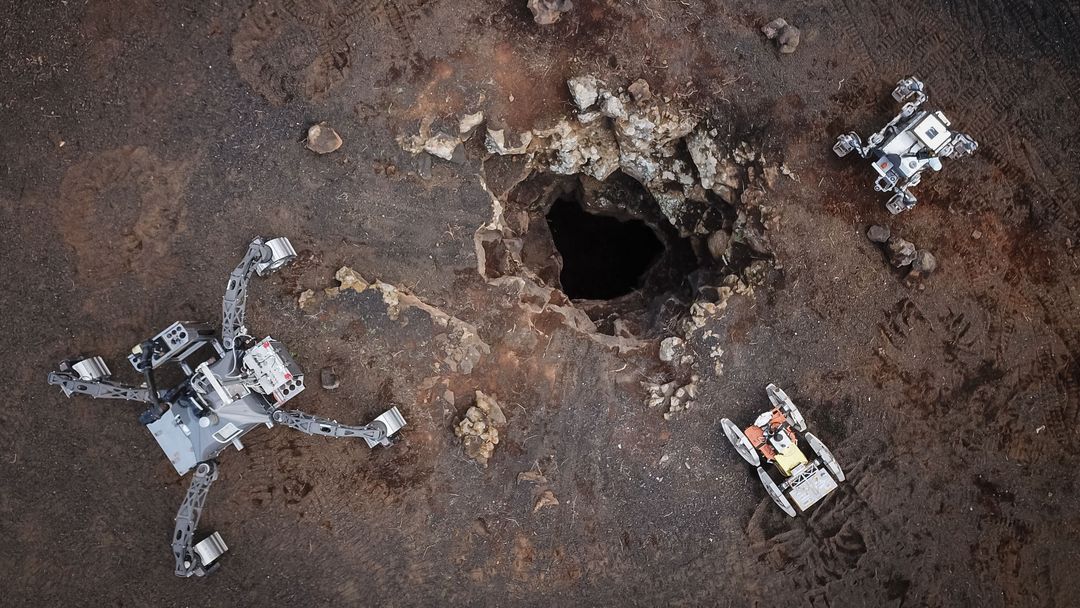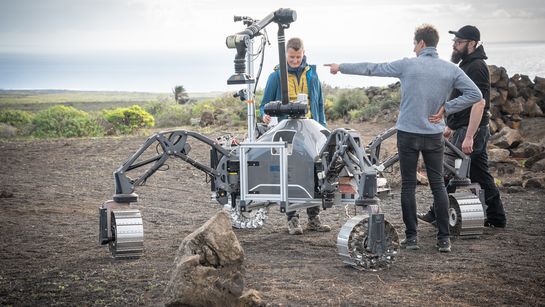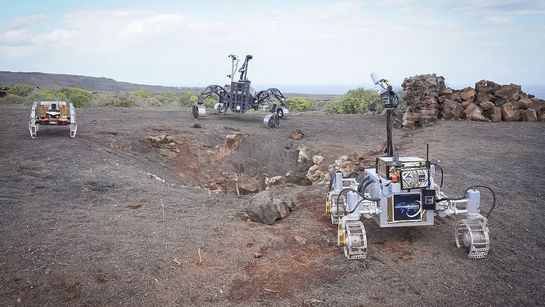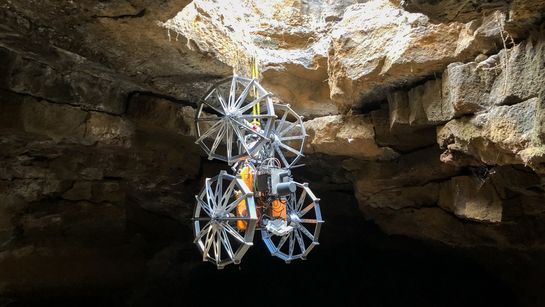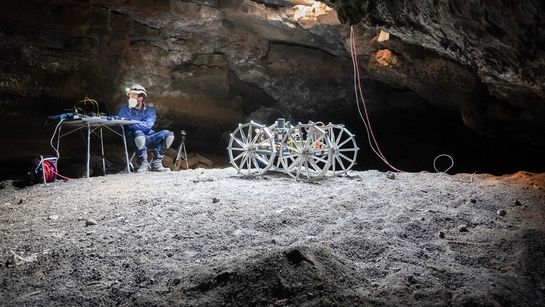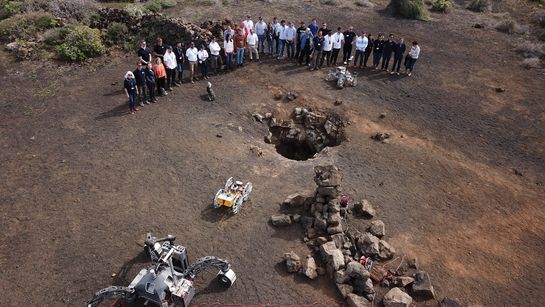A permanent station on the moon that can serve as a starting point for further exploration of our solar system is a crucial goal of international spaceflight. Optimal conditions for this could be found especially in hard-to-reach environments such as craters or lava tubes, which offer protection from radiation, meteorites, and temperature fluctuations. In addition, scientists suspect important resources such as frozen water in the lunar subsurface. However, before humans can venture into the depths of the Earth satellite, these promising locations are to be investigated by autonomous robots. But how do the robots get into the caves?
While today's spaceflight still relies on remote-controlled stand-alone systems, the future belongs to autonomous collaborative robotics. In the CoRob-X (Cooperative Robots for Extreme Environments) project coordinated by the DFKI Robotics Innovation Center in Bremen, Germany, nine European partners have been investigating an ambitious exploration concept based on the cooperation of several autonomous robotic systems since March 2021. CoRob-X was one of the final projects of the Strategic Research Cluster (SRC) "Space Robotics Technologies", which comprises several research projects that were funded under the European Commission's Horizon 2020 program and supervised by the PERASPERA Programme Support Activity (PSA). Within these projects, called Operational Grants, fundamental technologies or “Building Blocks” for robotic exploration missions were developed for use in future space missions – this includes an adaptive autonomy system for single and collaborative robots, a general software framework for sensor data fusion, environmental sensors for localization and 3D mapping, and a new electromechanical interface to couple robots to other systems or tools.
The focus of CoRob-X was to test if the technologies developed in the SRC can be used to enable the robots to work as a team in the exploration of a lava tube. The scenario involves three heterogeneous autonomous rovers – the DFKI robots "SherpaTT" and "Coyote III" and the rover "LUVMI-X" from the Belgian company Space Applications Services NV/SA – jointly investigating the entrance to a lava cave, the so-called skylight. With the help of a sensor cube that LUVMI-X shoots into the skylight, the team obtains initial information from inside the cave. Based on this data, the systems determine a suitable location where the robust SherpaTT can support the compact Coyote III rappelling down into the lava tube using a wire rope. Once on the ground, the agile rover decouples from the rope and the docking mechanism and explores the cave.
To prove the feasibility of this complex mission, around 25 project members traveled to Lanzarote from January 21 to February 11, 2023. After almost two years of intensive research and development work and several weeks of integration activities last September at the DFKI in Bremen, it was now the time to test the functionality of the technologies in a realistic environment. With its extensive lava tunnels, the volcanic island offers ideal conditions for carrying out analog missions like this one. The project team set up its tents right next to a lava cave entrance, an approximately five-meter-wide hole in the volcanic soil that granted access to the approximately four-meter-deep cave – the perfect place to extensively put the components and systems to the test and to carry out the individual mission phases. In the coming weeks, the participants were not only confronted with extremely changeable weather conditions, but also had to repeatedly overcome scientific and technical challenges, which sometimes demanded working hours late into the night.
The three-week tests concluded with the final demonstration of the overall mission in front of external visitors, including representatives of the European Commission, the European Space Agency (ESA), the German Aerospace Center (DLR), the Spanish Centro para el Desarrollo Tecnológico Industrial (CDTI) and the French Centre national d'études spatiales (CNES). The first mission phase went smoothly, with the robotic team approaching the cave entrance while scanning and creating a map of the surrounding area. In the second stage, LUVMI-X carried the sensor cube through the skylight into the cave interior. To simulate the lunar drop velocities, an electric winch and cable were used to lower the cube. The data recorded in the process provided a precise 3D map of the cave entrance. The goal of the third mission phase was to reach the cave interior by lowering Coyote III. To do this, the rover docked via an interface to a cable and docking station provided by SherpaTT. A rope attached to it allowed it to slowly descend through the skylight and then land safely on the cave floor. Once down, the fourth and final phase of the mission began: Coyote III explored the unknown terrain and successfully created a map of the cave environment.
Overall, the external guests were highly impressed by the performance of the entire CoRob-X team and considered the field tests a great success and a milestone for future long-term missions on the Moon.
Christos Ampatzis, head of the Space Technologies Section at the European Commission's Health and Digital Executive Agency (HADEA), summarized: "As the final episode in a series of projects of the Strategic Research Cluster on Space Robotics, CoRob-X has successfully integrated and demonstrated the developed technology building blocks in the context of a very ambitious and challenging space research scenario. We are very pleased that the project not only allowed us to demonstrate European capabilities in space robotics, but also to cross existing boundaries and lay the foundations for future space missions."
Gianfranco Visentin, head of the Automation and Robotics Section at the European Space Agency (ESA) and coordinator of the PERASPERA Program Support Activity, highlighted the importance of analog testing for space research: "Why do we perform analog tests? The reason is very simple. A natural environment contains a lot of things that we don't expect in the lab. In a real environment, such as a lava cave, which exists exactly like this on the moon, we can experience all the variability of conditions created by nature, and we can test the robustness of engineering systems that need to function in extreme situations."
Dr. Thomas Vögele, project coordinator at DFKI, described the analog mission in Lanzarote as "a real challenge for both researchers and robots. The exploration of a lava cave with three autonomous rovers has not been demonstrated in this form before CoRob-X. We've shown that it's possible, and hopefully we're one step closer to a real lunar mission now."
Just before the Lanzarote analog mission, the company GMV Aerospace and Defense SA and the Santa Bárbara Foundation had conducted field tests in a mine in northern Spain to demonstrate the functionality of the SRC technologies in a terrestrial application scenario. A rover and a drone from the Spanish GMV were used to inspect mining tunnels. In close cooperation, the systems succeeded in inspecting a shaft after an explosion to rule out possible hazards to humans.
CoRoB-X has received funding from the European Union's Horizon 2020 research and innovation programme under grant agreement No GA 101004130. The project partners included:
- German Research Center for Artificial Intelligence (DFKI), Robotics Innovation Center (DE)
- Space Applications Services NV/SA (BE)
- GMV Aerospace and Defence SA (SP)
- Magellium SAS (FR)
- Laboratoire ATMosphères et Observations Spatiales (LATMOS) (FR)
- Fondacion Santa Bárbara (SP)
- University of Malaga (SP)
- Sintef AS (NO)
- Airbus Defence and Space GmbH (DE)
Further information
Project website: https://www.corob-x.eu/
CoRob-X Field Trials Blog, Lanzarote 2023 – In a multimedia blog, DFKI project members regularly reported on current events on site: https://www.dfki.de/web/forschung/field-trials-lanzarote

